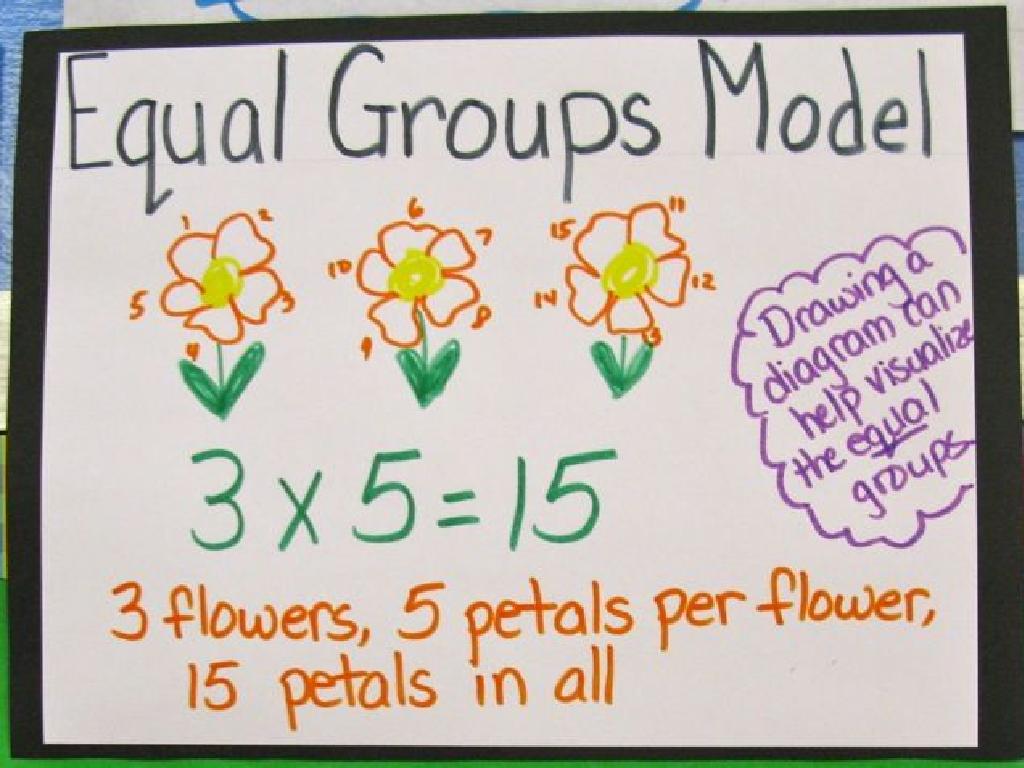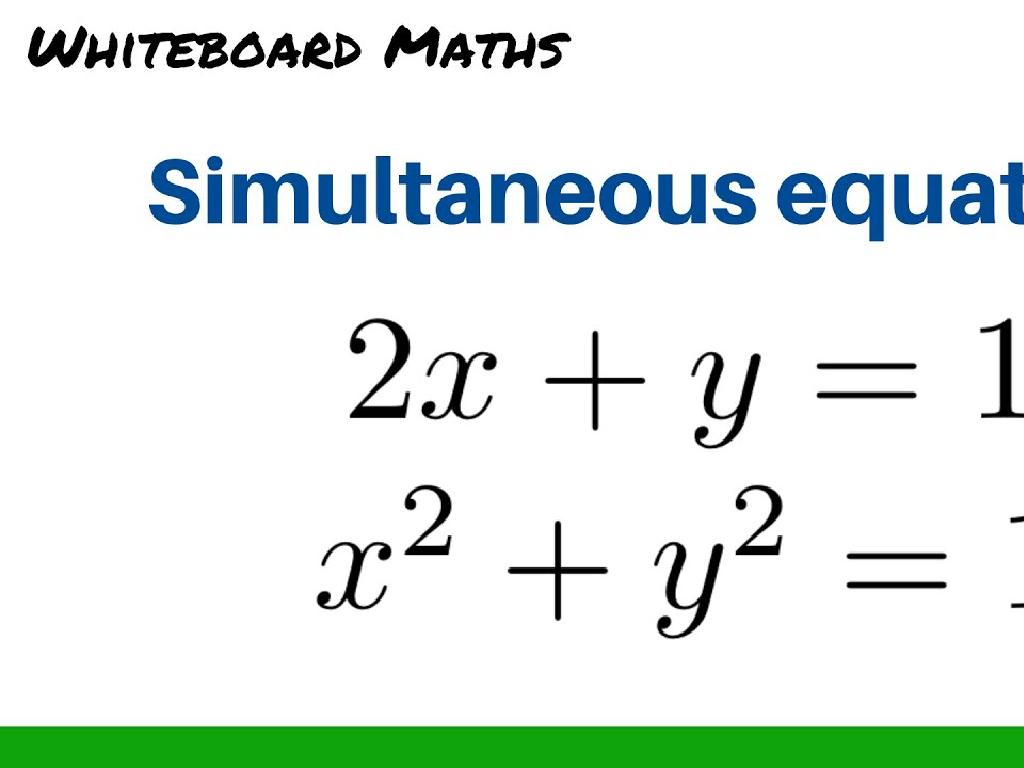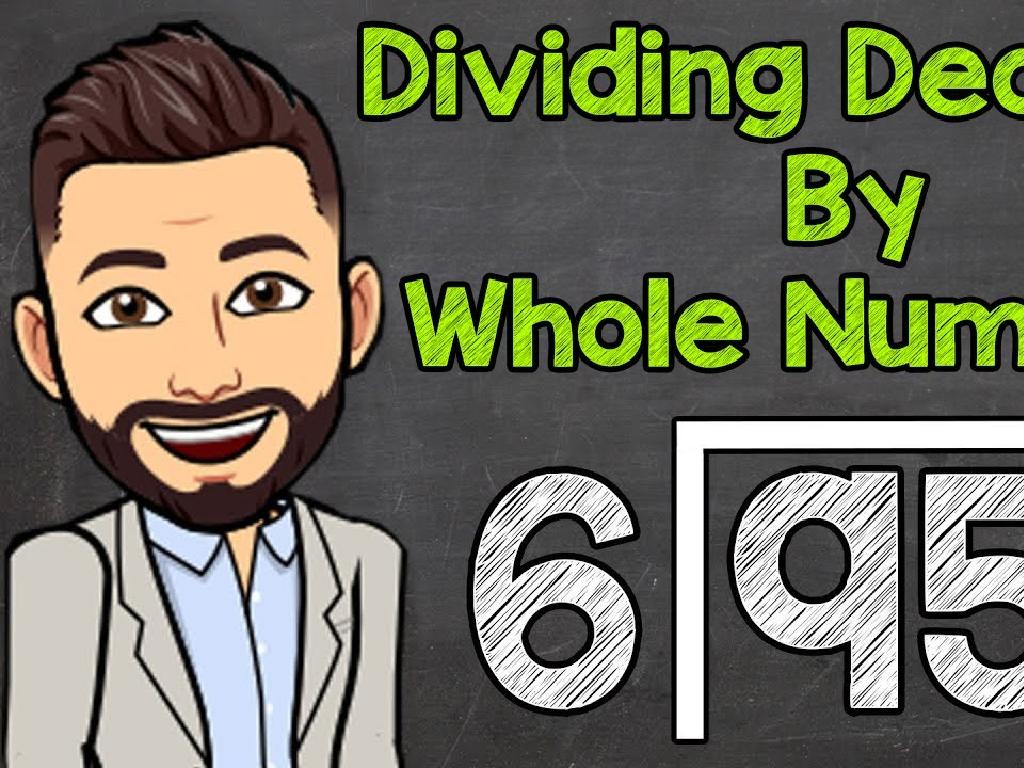Find What Percent One Number Is Of Another
Subject: Math
Grade: Eighth grade
Topic: Percents
Please LOG IN to download the presentation. Access is available to registered users only.
View More Content
Introduction to Percents
– Understanding daily life percents
– How sales tax, discounts, and interest rates relate to percents
– Defining ‘Percent’
– ‘Percent’ means parts per hundred
– Common uses in everyday scenarios
– Used in statistics, finance, and health
– Calculating percentages
– Use the formula (part/whole) x 100 to find the percentage
|
This slide introduces students to the concept of percents and their relevance in everyday life. Begin by discussing how percents are encountered daily through sales tax, discounts, and interest rates. Explain that the term ‘percent’ comes from the Latin ‘per centum,’ meaning ‘by the hundred,’ which is a ratio where a number is compared to 100. Highlight common uses of percents in various fields such as statistics, finance, and health to show practical applications. Teach students the basic formula for calculating percentages, which is (part/whole) x 100, and provide examples to illustrate this. Encourage students to think of other areas where they encounter percents and to practice calculating percentages with real-world examples.
Relating Percents to Fractions and Decimals
– Understand percent as part of 100
– A percent represents a number out of 100
– Convert fractions to percents
– To convert, multiply the fraction by 100
– Convert decimals to percents
– Multiply the decimal by 100 to get the percent
– Practice with examples
– 1/2 becomes 50%, 0.75 becomes 75%
|
This slide introduces students to the concept of percents in relation to fractions and decimals, which is a fundamental aspect of understanding percentages. Emphasize that ‘percent’ means ‘per hundred,’ making it a part of 100. Show students how to convert fractions to percents by multiplying by 100 and simplifying. Similarly, demonstrate converting decimals to percents by multiplying by 100. Use clear examples like 1/2 and 0.75 to illustrate these conversions. Encourage students to practice with additional examples and to find the percent representation of various fractions and decimals they encounter in their daily lives.
Calculating Percentages
– Understand the percentage formula
– The formula is Part/Whole x 100 to find the percentage
– Identify ‘Part’ and ‘Whole’
– ‘Part’ is the portion of the total, ‘Whole’ is the total amount
– Practice: Percent of 25 in 200
– Calculate: What percentage is 25 of 200?
– Apply formula to find percentage
– Use the formula: 25/200 x 100 = 12.5%
|
This slide introduces students to the concept of calculating percentages, a fundamental skill in mathematics and real-life applications. Begin with the percentage formula, ensuring students understand that ‘Part’ refers to a portion of the ‘Whole,’ which is the total amount. Use the practice problem to illustrate how to apply the formula by dividing the ‘Part’ (25) by the ‘Whole’ (200) and then multiplying by 100 to find the percentage. This example solidifies their understanding and prepares them for more complex problems. Encourage students to solve similar problems and understand the practicality of percentages in everyday contexts such as shopping discounts, statistics, and data analysis.
Calculating Percentages in Real Life
– Use the percentage formula
– The formula is Part/Whole x 100 = Percentage
– Example: Percent of 50 in 250
– What % is 50 of 250? (50/250) x 100 = 20%
– Discuss importance in life
– Apply to different contexts
– Useful in finance, shopping, statistics
|
This slide aims to teach students how to find the percentage one number is of another using a formula. Start by explaining the formula Part/Whole x 100 = Percentage. Provide a step-by-step example with 50 as a part of 250, showing that 50 is 20% of 250. Emphasize the importance of understanding percentages in everyday life, such as calculating discounts, understanding statistics, and managing finances. Encourage students to think of other scenarios where they might need to use this skill and to practice with different numbers to become comfortable with the concept.
Word Problems and Percentages
– Apply knowledge to solve problems
– Example: Class test percentage
– If 30 out of 150 students passed, what % is that?
– Steps to solve percentage problems
– Convert the problem into an equation: (30/150) x 100
– Tips for tackling word problems
– Read carefully, identify numbers involved, and use formulas
|
This slide aims to help students apply their understanding of percentages to solve word problems. Start with a relatable example, such as finding out what percent of students passed a test in a class. This concrete example will help students visualize the problem. Walk them through the steps of solving the problem by converting the numbers into a fraction and then into a percentage. Emphasize the importance of reading the problem carefully, identifying the numbers and the question being asked, and then applying the percentage formula. Provide tips such as underlining key information and double-checking calculations. Encourage students to practice with additional problems for mastery.
Interactive Practice: Percentage Calculations
– Interactive example walkthrough
– Pair up for practice problems
– Find a partner and work on assigned problems
– Solve percentage problems together
– Use the formula ‘Part/Whole x 100 = Percent’
– Discuss solutions and feedback
– Share your answers with the class for feedback
|
This slide is designed to engage students in an interactive learning experience. Begin with a guided example of finding percentages, ensuring to involve the class by asking questions throughout the process. Next, have students pair up to tackle a set of problems that require them to find what percent one number is of another. Encourage collaboration and peer teaching. After solving the problems, pairs will present their solutions to the class for immediate feedback, fostering a discussion that allows for clarification and reinforcement of the concept. Provide at least 4-5 different percentage problems for variety and to cater to different skill levels within the class.
Class Activity: Percentage Scavenger Hunt
– Find classroom items for percentage calculation
– Work in groups for the scavenger hunt
– Calculate the percentages of each item
– Use the formula: (part/whole) x 100
– Present findings to the class
|
This interactive class activity is designed to help students apply their knowledge of percentages to real-world objects. Divide the class into small groups and assign each group the task of finding various items around the classroom. Each group will then calculate what percentage one item is of another, using the formula (part/whole) x 100. For example, if there are 20 desks and 4 are blue, what percent are blue desks? After calculations, groups will present their findings, explaining their process and reasoning. This activity not only reinforces mathematical concepts but also fosters teamwork and presentation skills. Possible variations of the activity could include finding percentages of book types, colors of markers, or types of supplies.
Wrapping Up: Percentages
– Recap of percentage concepts
– Significance of learning percentages
– Percentages are vital in various real-life scenarios like shopping discounts, statistics, and finance.
– Homework: Problem set assignment
– Solve the provided problems to reinforce today’s lesson.
– Be prepared to discuss solutions
– We’ll review answers and methods in the next class.
|
This slide aims to summarize the key points from today’s lesson on percentages, emphasizing their importance in everyday life and various academic fields. The homework assignment consists of a set of practice problems that will help students apply what they’ve learned and solidify their understanding of how to find what percent one number is of another. Encourage students to attempt all problems and remind them that we will go over the solutions in the next class, addressing any questions or difficulties they may have encountered. This will not only help them grasp the concept but also build their confidence in using percentages.






